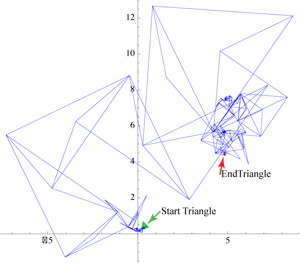This problem may be reduced to computation of the Lyapunov exponent of a simple stochastic sequence.
Clearly, all triangles so generated are isosceles. Let $a_n$ be the common length of two equal sides and $2\phi_n$ the angle between them ($0\leq\phi_n\leq\pi/2).$ Then by elementary trigonometry,
$$a_{n+1}=R_n=a_n/2\cos(\phi_n), \quad
\phi_{n+1}=\begin{cases}\pi/2-\phi_n,\qquad\qquad\qquad p=2/3 \\ \begin{cases}
2\phi_n \text{ if }\phi_n\leq\pi/4\\ \pi-2\phi_n \text{ if }\phi_n\geq\pi/4\end{cases}
\ p=1/3\end{cases}.$$
Therefore, in the triangles shrink to a point (in the sense of their size, regardless of the location), $a_n\to 0$ a.s. if and only if $\prod_n 2\cos(\phi_n)$ a.s. diverges to $\infty.$ If, moreover, the Lyapunov exponent (i.e. the exponential divergence rate) is greater than 1 then the triangles themselves also converge a.s. to a point.
(continued)
The behavior of the stochastic sequence $\{\phi_n\}$ strongly depends on the diophantine properties of $\phi_0.$ There are a.s. finitely many distinct terms if and only if $\phi_0$ is rational, i.e. commensurable with $\pi$. It a.s. contains $0$ if and only if $\phi_0$ is a dyadic rationale: the triangles will a.s. "blow up" after getting 3 collinear points whose circumcenter is at infinity. In the rational case $\phi_0=\pi p/q$ with odd $q$, the stochastic sequence is an irreducible finite Markov chain. The Lyapunov exponent can be computed from the stationary distribution by matrix algebra. For example, if $\phi_0=\pi/6$ then there are two states, $\pi/3$ and $\pi/6,$ the transition matrix is $\begin{bmatrix}1/3 & 1\\ 2/3 & 0\end{bmatrix}$
and the stationary distribution is $(3/5,2/5),$ which yields
$$\lambda=(2\cos\pi/3)^{3/5}(2\cos\pi/6)^{2/5}=3^{1/5}>1.$$
Thus starting with an equilateral triangle, two similarity classes of triangles will occur, equilateral ($\phi=\pi/6$) with $p=2/5$ and $(2\pi/3,\pi/6,\pi/6)$ ($\phi=\pi/3$) with $p=3/5.$ Under the iteration, the smaller side will scale down by factor $\sqrt{3}$ in the equilateral case and stay the same in the obtuse case, with the average shrinkage factor $3^{1/5}.$ I see how to carry out similar analysis in general, but I wouldn't do it here.
On the other hand, from ergodic theory it should follow that for almost all $\phi_0$ the sequence $\{\phi_n\}$ will be equidistributed $\mod \pi/2.$ Observe that $\cos(\phi_n)=\pm\cos(\psi_n),$ where $\{\psi_n\}$ is a stochastic sequence $\mod \pi$
$$\psi_{n+1}=\begin{cases}\pi/2-\psi_n,\ \ \, p=2/3 \\
2\psi_n,\quad\quad\quad p=1/3\end{cases}.$$
My heuristic computation of the Lyapunov exponent gives
$$\ln\lambda=\frac{1}{\pi}\int_{0}^{\pi}\ln(2|\cos(\psi)|) d\psi=0,$$
so generically $\lambda=1$ and it remains unclear whether the sizes of the triangles go to zero. This will be difficult to see using graphical simulations due to roundoff errors, but with a bit of care, you can numerical simulate the sequence $\psi$ directly, compute
$\prod_{k=1}^n 2\cos(\psi_k),$ and study its asymptotics. I have analyzed a similar problem in which you always replace the vertex where two equal sides meet: this corresponds to the deterministic sequence $\psi_{n+1}=2\psi_n$ and the sides do not go to zero, because
$$a_{n}=\frac{\sin(2^{n+1}\psi_0)}{\sin(\psi_0)}a_0.$$

